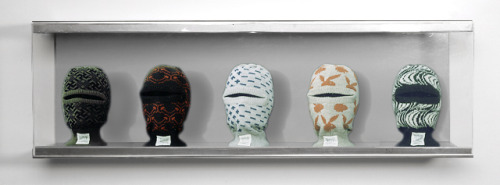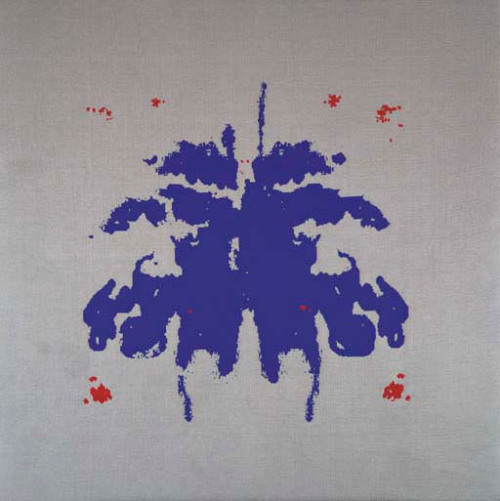Balaklava, knitted wool, 1986.
Rosemarie Trockel (born November 13, 1952 in Schwerte, North Rhine-Westphalia) is a German artist and an important figure in the international contemporary art movement. Trockel lives and works in Cologne, and teaches at the Kunstakademie Düsseldorf.
From 1970–1978, Trockel addressed contemporary concerns, particularly women and their place in the art world. Her work challenged concepts of sexuality, culture, and artistic production. In the 1980s, she had important solo shows in the United States, for example at the Museum of Modern Art (MoMA), New York.
Trockel's "knitting pictures", produced in 1985, consist of lengths of machine-knitted, woolen material stretched onto frames. The material is patterned with computer-generated geometrical motifs, or with recognizable logos, such as the hammer and sickle motif of the Soviet Union superimposed on a background of red and white stripes reminiscent of the US flag.
http://en.wikipedia.org/wiki/Rosemarie_Trockel
Untitled (Hammer & Sickle), knitted wool, 1986
In 1985 Trockel produced her first ‘knitting pictures’, consisting of
lengths of machine-knitted woollen material stretched on to frames. The
material is patterned with computer-generated geometrical motifs or
recognizable logos, for example the hammer-and-sickle motif of the
Soviet Union ironically superimposed on a background of red-and-white
stripes that recall the US flag (Untitled, 1986). The knitted works are ironic comments on the traditionally
feminine occupation of knitting placed in a context of mass production.
Nina Lübbren
http://www.moma.org/collection/artist.php?artist_id=5933
Untitled, knitted wool, 1988
Above all, her machine-produced knitting pictures are what decisively
advanced her current international fame. Rosemarie Trockel succeeded in
countering the predominantly hand-knitted, home-made, amateur
handicrafts orientation of women’s art in the 1970’s not only with full
conceptual rigour, but also with subtle irony. The connotations of
homespun dowdiness of the applied feminine creativity of the time, and
also of the activities of women who were frequently tied to the home
during the years of Germany’s Economic Miracle, flowed ex negativo into the semiotics of their sculptural works.
Years
ago, Rosemarie Trockel once admitted in an interview that during her
university studies, the knitting mania of her fellow women students,
most of them avowed counterculture adherents, really got on her nerves.
This was what motivated her to set her course against the “hand-crochet
products” widespread among women artists with serially-produced works
and sardonic intellectuality.
Birgit Sonna
http://www.goethe.de/kue/bku/kpa/en6314215.htm
Untitled (Rorschach Test), knitted wool on canvas, 1993
From year to year her approach is a fertile reassessment, at times a
negation and at other times an unexpected reaffirmation, of her earlier
work. In the 1980s the knitted ‘paintings’ were her ticket to fame, her
‘thing’: tongue-in-cheek computerized knitting patterns using logos
ranging from the Playboy bunny to the Woolmark logo to a swastika, hit
the Zeitgeist nail on the head in an almost too perfect illustration of
the Baudrillardian notion of a devaluing swirl of signs. The knitted
pictures will be central to Trockel’s Cologne show: on one level they
are a play on the indifference of a pluralist model that absorbs all
values, but on another they may expose the variety of knitted works as a
system flexible enough to counter its more simplifying Postmodern
readings. I’m thinking of works such as the untitled knitted ‘painting’
of 1989 comprising two speech bubbles: Bitte tu mir nichts – ‘please
don’t hurt me’ – one exclaims in letters that look handwritten, while
the other reads aber schnell – ‘but hurry up!’ The ambivalence here – is
it a child begging her parent not to smack her before being told to
hurry up, or is it a woman who delivers both sentences, confronted with
the prospect of sexual violence? – is accentuated by the fact that the
speech bubbles are ‘hanging’ vertically from the top of the beige
picture plane, hovering high in the sky over a low black horizon, as if
they were exclaimed by invisible forces up above. It becomes clear that
the exchange could just as well refer to how market forces co-define the
(female) artist’s work situation: ‘please don’t hurt me’, ‘but hurry
up!’
Jorg Heiser
http://www.frieze.com/issue/article/the_seeming_and_the_meaning/
Tuesday 6 August 2013
Subscribe to:
Post Comments (Atom)





No comments:
Post a Comment